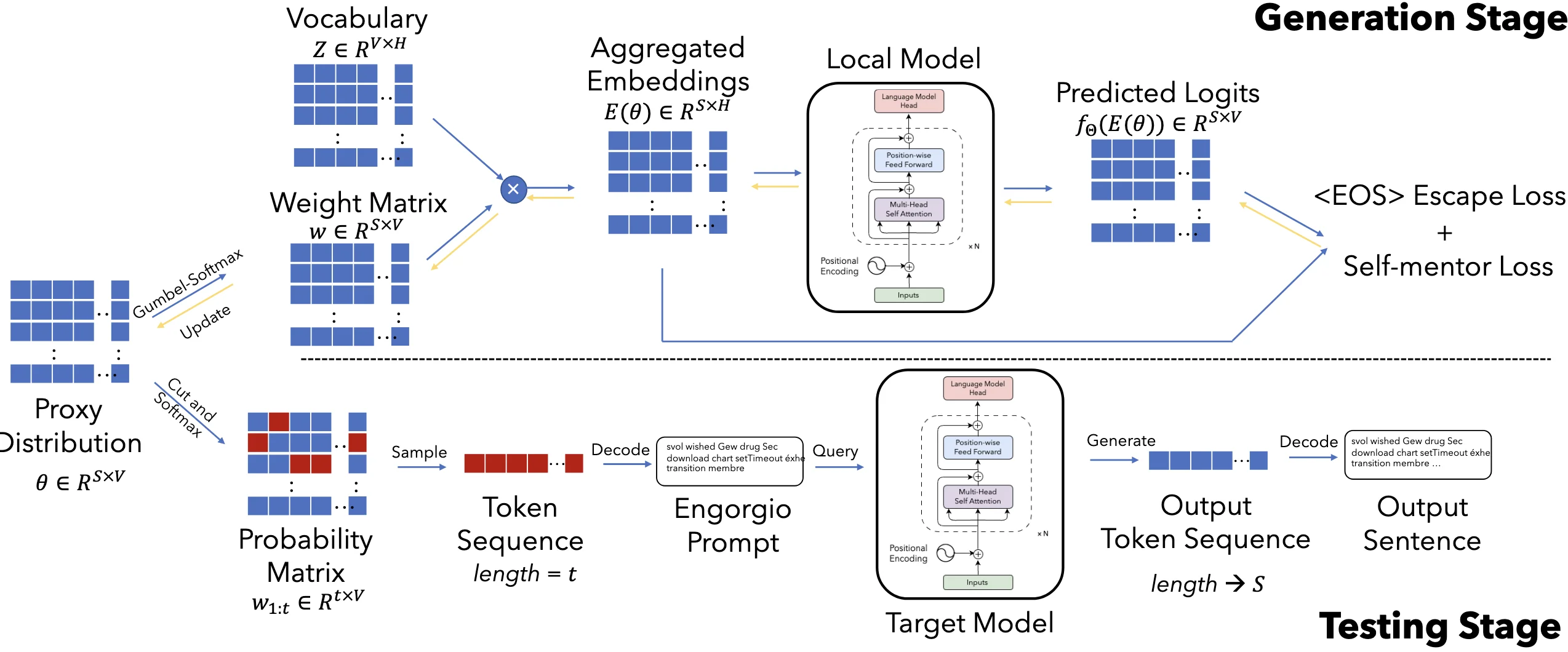engorgio prompt¶
约 1454 个字 59 行代码 3 张图片 预计阅读时间 6 分钟
an engorgio prompt makes large language model babble on


算法设计 ¶
meaning of terms¶
- \(S\) 是提示词的最大长度(比如 10 个词
) 。 - \(V\) 是词表大小(比如 5 万个可能的词
) 。 - \(H\) 是词嵌入维度(比如 768
) 。
例子
\(S=5\):提示词最多 5 个 token(如“详细解释以下步骤”
\(V=50257\):从 GPT-3 的 50257 个词中选择每个位置的词。
\(H=12288\)(GPT-3 的嵌入维度
- \(\theta\in \mathbb{R}^{S \times V}\),其中 \(\theta_i \in \mathbb{R}^V\) 是第 \(i\) 个位置选择每个词的概率。
- 词表 vocabulary \(Z \in \mathbb{R}^{V \times H}\) 是所有可能的词的集合。
- \(\omega \in \mathbb{R}^{S \times V}\) 是权重,其中 \(\omega_i \in \mathbb{R}^V\) 是第 i 个位置选择每个词的概率。\(\sum_{j=1}^V(\omega_i)_j=1.\)
- \(e(j) \in \mathbb{R}^H\) 是第 \(j\) 个 token 的词嵌入。
- \(\tilde{e}(\theta_i) \in \mathbb{R}^H\) 是 " 软 " 词向量,其中 \(\tilde{e}(\theta_i)\) 是第 i 个位置选择每个词的词嵌入。
- Engorgio prompt \(\mathcal{T}\) 是提示词,其中 \(\mathcal{T} \in \mathbb{R}^{S \times H}\) 是提示词的词嵌入。

1. 概率矩阵 proxy distribution \(\theta\) 是什么?¶
- 形状:矩阵 \(\theta\) 的大小是 \(S \times V\),其中:
- 作用:\(\theta\) 的每一行(\(\theta_i\))表示第 \(i\) 个位置选择每个词的概率。
例如:\(\theta_1 = [0.01, 0.8, 0.1, ...]\) 表示第一个词选第 2 个词(概率 0.8) 。
2. 如何用 \(\theta\) 生成提示词?¶
步骤 1:Gumbel-Softmax 采样
对 \(\theta\) 的每一行(\(\theta_i\))加噪声(Gumbel 噪声
- 温度参数 \(\tau\):控制随机性(\(\tau\) 越小,\(w_i\) 越接近 one-hot,即确定选某个词
) 。 - 例如:\(\theta_1 = [0.2, 0.5, 0.3] \rightarrow w_1 \approx [0.1, 0.8, 0.1]\)(倾向于选第 2 个词
) 。
步骤 2:生成 " 软 " 词嵌入 用权重 \(w_i\) 对词嵌入(\(e(j)\))加权求和,得到"软"词向量:
例如:如果 \(w_1\) 倾向于 " 解释 ",则 \(\tilde{e}(\theta_1)\) 接近 " 解释 " 的词向量。
步骤 3:输入模型生成文本 - 将 \(\tilde{e}(\theta_1), \tilde{e}(\theta_2), ...\) 输入模型,生成文本并计算损失(如避免过早结束、内容相关性等)。 - 通过损失反向传播更新θ,优化提示词的选择。
\(\mathcal{L}_{esc}\) eos escape loss¶
减少<EOS> token 在所有位置出现的概率
这个损失函数 \(\mathcal{L}_{esc}(\theta)\) 的目标是:降低模型在生成过程中过早输出 <EOS>(结束符)的概率,从而让生成的内容更完整(避免“话说到一半突然结束”
- \(E(\theta)_{1:i}\):前 \(i\) 步生成的文本的嵌入表示(Embedding
) 。 - \(f_\Theta\):目标模型(如 GPT)的预测函数,输出所有词的概率分布。
- \(\text{Softmax}(...)_\kappa\):模型在第 \(i\) 步预测
<EOS>的归一化概率(\(\kappa\) 是<EOS>的 token 索引) 。 - \(\sum_{i=1}^S\):累加所有生成步长的
<EOS>概率。
为什么用 Softmax 概率?
直接降低 <EOS> 的绝对概率可能无效(因为模型对其他词的绝对概率也会变化<EOS> 还是其他词”。
\(\mathcal{L}_{sm}\) Self-Mentor Loss¶
自指导损失
增强生成的 Engorgio Prompt(\(\mathcal{T}\))与模型输出之间的相关性,确保 Prompt 能稳定地引导模型生成更长的、符合预期的文本。
- \(E(\theta)_{1:i}\):前 \(i\) 个 token 的嵌入表示(Embedding
) 。 - \(f_{\Theta}\):目标模型的预测函数,输出下一个 token 的概率分布。
- \(w_{i+1}\):代理模型生成的 \(i+1\) 位置 token 的权重(通过 Gumbel-Softmax 从 \(\theta\) 得到
) 。 - \(\mathcal{L}\):交叉熵损失,衡量目标模型预测与代理模型权重的差异。
Exp¶
metrics¶
Avg-len
average token number of the generated outputs
Avg-rate
the ratio of the LLM outputs that reach the maximum length
models¶
OpenRoute17, Codestral18, Huggingface serverless inference API19, and GitHub Models20
代码复现 ¶
我的环境,先使用 2080Ti 进行环境配置和验证,后面用 3090 跑了
模型下载 ¶
Download checkpoints manually and configure the paths in ica_utils/model.py
AutoTokenizer.from_pretrained('/PATH/TO/THE/FILES')
AutoModel.from_pretrained('/PATH/TO/THE/FILES')
openai-community/gpt2-large at main
export HF_ENDPOINT=https://hf-mirror.com
huggingface-cli download --resume-download openai-community/gpt2-large --local-dir ~/Engorgio-prompt/models/gpt2-large
修改ica_utils/model.py 152 行的模型本地路径
def get_model(model_name, args):
if model_name.startswith('gpt2'):
local_path = '~/Engorgio-prompt/models/gpt2-large'
tokenizer = GPT2Tokenizer.from_pretrained(local_path)
model = GPT2LMHeadModel.from_pretrained(local_path).cuda()
运行问题 ¶
问题 1 KeyError: 'gpt2'
Traceback (most recent call last):
File "/root/autodl-tmp/Engorgio-prompt/./ica_code.py", line 181, in <module>
main(args)
File "/root/autodl-tmp/Engorgio-prompt/./ica_code.py", line 40, in main
template_fac = TemplateFactory(
File "/root/autodl-tmp/Engorgio-prompt/ica_utils/prepare.py", line 91, in __init__
self.add_additional_prompt("")
File "/root/autodl-tmp/Engorgio-prompt/ica_utils/prepare.py", line 94, in add_additional_prompt
conv : templates.Conversation = templates.conv_templates[convert_name[self.model_name]].copy()
KeyError: 'gpt2'
这里可能是名字写错了,我把代码中所有位置的gpt2都改成了gpt2-large
问题 2 Compile with TORCH_USE_CUDA_DSA to enable device-side assertions
报错信息
Traceback (most recent call last):
File "/root/autodl-tmp/Engorgio-prompt/./ica_code.py", line 184, in <module>
main(args)
File "/root/autodl-tmp/Engorgio-prompt/./ica_code.py", line 102, in main
pred = model(inputs_embeds=inputs_embeds_x).logits
File "/root/miniconda3/envs/sftenv/lib/python3.10/site-packages/torch/nn/modules/module.py", line 1773, in _wrapped_call_impl
return self._call_impl(*args, **kwargs)
File "/root/miniconda3/envs/sftenv/lib/python3.10/site-packages/torch/nn/modules/module.py", line 1784, in _call_impl
return forward_call(*args, **kwargs)
File "/root/miniconda3/envs/sftenv/lib/python3.10/site-packages/transformers/models/gpt2/modeling_gpt2.py", line 1075, in forward
transformer_outputs = self.transformer(
File "/root/miniconda3/envs/sftenv/lib/python3.10/site-packages/torch/nn/modules/module.py", line 1773, in _wrapped_call_impl
return self._call_impl(*args, **kwargs)
File "/root/miniconda3/envs/sftenv/lib/python3.10/site-packages/torch/nn/modules/module.py", line 1784, in _call_impl
return forward_call(*args, **kwargs)
File "/root/miniconda3/envs/sftenv/lib/python3.10/site-packages/transformers/models/gpt2/modeling_gpt2.py", line 899, in forward
outputs = block(
File "/root/miniconda3/envs/sftenv/lib/python3.10/site-packages/torch/nn/modules/module.py", line 1773, in _wrapped_call_impl
return self._call_impl(*args, **kwargs)
File "/root/miniconda3/envs/sftenv/lib/python3.10/site-packages/torch/nn/modules/module.py", line 1784, in _call_impl
return forward_call(*args, **kwargs)
File "/root/miniconda3/envs/sftenv/lib/python3.10/site-packages/transformers/models/gpt2/modeling_gpt2.py", line 388, in forward
hidden_states = self.ln_1(hidden_states)
File "/root/miniconda3/envs/sftenv/lib/python3.10/site-packages/torch/nn/modules/module.py", line 1773, in _wrapped_call_impl
return self._call_impl(*args, **kwargs)
File "/root/miniconda3/envs/sftenv/lib/python3.10/site-packages/torch/nn/modules/module.py", line 1784, in _call_impl
return forward_call(*args, **kwargs)
File "/root/miniconda3/envs/sftenv/lib/python3.10/site-packages/torch/nn/modules/normalization.py", line 217, in forward
return F.layer_norm(
File "/root/miniconda3/envs/sftenv/lib/python3.10/site-packages/torch/nn/functional.py", line 2905, in layer_norm
return torch.layer_norm(
torch.AcceleratorError: CUDA error: device-side assert triggered
CUDA kernel errors might be asynchronously reported at some other API call, so the stacktrace below might be incorrect.
For debugging consider passing CUDA_LAUNCH_BLOCKING=1
Compile with `TORCH_USE_CUDA_DSA` to enable device-side assertions.
错误出现的场景
这个报错发生在模型训练的反向传播阶段,具体来说是loss.backward()这一步。根据错误信息提示Compile with ‘TORCH_USE_CUDA_DSA’ to enable device-side assertions,可以看出这是一个与 CUDA 设备端相关的警告或错误。
经过调试和分析,我发现真正的原因是 GPU 显存不够用。在深度学习中,反向传播(loss.backward())需要计算梯度,这会占用大量显存。如果当前batch_size设置过大,或者模型本身参数量较多,就可能导致显存溢出(Out of Memory, OOM
nvidia-smi
发现显存占用很高,所以需要降低batch_size
解决方法:
- 换用显存更大的显卡
- 降低
--bs、--max_length。 - 选用更小的
--model(词表 /hidden/ 层数更小) 。
环境配置 ¶
At first, I created a conda environment with the environment.yml file.
conda env create -f environment.yml
Problem 1 No module named 'torch.distributed.device_mesh'
pip install --upgrade torch torchvision torchaudio
Problem 2 Cannot import name 'Cache' from 'transformers'
I solve this problem by installing the peft package.(Thanks to Cannot import name 'EncoderDecoderCache' from 'transformers' - Stack Overflow)
pip install peft==0.10.0
Problem 3 ModuleNotFoundError: No module named ‘triton.ops‘
Error reason: After May 21, 2024, triton.ops has been moved to another project triton-lang/kernels.(Issue #5471 · triton-lang/triton)
Solution:
pip install triton==2.3.0